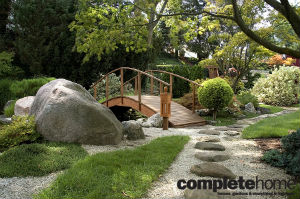
Story & photos: Diane Norris
The very first thing that struck me as I entered this inner-urban estate in Sydney was the vastness of the outdoor spaces. The next was the fabulously coloured foliage and an oasis-like ambience that was all-pervading. I had left the noisy streets behind and entered a peaceful and lush sanctum which, I must say, was extremely unexpected.
It was a very warm summer’s day but the gorgeous bright-green foliage from the avenue of trees along the main pathway provided cool shade. The colours of the plants in the multiple gardens beds jumped towards me with a tropical vibrancy and the sparkle of the bright-blue pool was exceedingly inviting. All in all, it was the complete ‘resort-style’ outdoor experience.
With more people living in medium-density inner-urban estates, which developers and estate agents like to promote as villages, landscaped communal areas, whether for sitting, swimming, barbecuing or just looking at, have become the ‘new backyard’ for growing numbers of urban dwellers. Glebe Gardens is one such development. It is just a stone’s throw away from the heart of Sydney and is a perfect example of the growing trend towards having professionally designed and landscaped communal outdoor areas for residents to enjoy.
Built in 1997, Glebe Gardens comprises 103 dwellings including terrace-style townhouses, apartments and villas set along three street frontages. There are several hundred residents living here — singles, busy professional couples, young families and retirees — and all have access to the landscaped grounds and communal facilities, the focal point of which is a centrally located 25-metre swimming pool.
To make the landscaping an even more impressive achievement, the whole garden area is built on top of an underground car park that lies beneath the site. This meant that all the plants had to be grown in specially constructed raised garden beds.
As the original communal gardens were looking tired, the Owners Corporation of Glebe Gardens employed Helen Young, a Sydney-based horticulturist who specialises in garden renovations, to formulate a plan to rejuvenate the dated and deteriorating outdoor spaces.
Helen’s brief was quite simple as it only involved the softscaping — all the hardscape elements, such as retaining walls, paving, garden beds and pool surrounds, were already in place and weren’t to be altered. The planting design was to be lush and resort-like. and to accommodate the opposite aspects to be found on each side of the estate — one side faces west and thus is exposed mostly to hot sun, the other side faces east with lots of winter shade. To accommodate these widely differing aspects, Helen decided to do the work in two stages, the first stage incorporating the west-facing side, courtyard and pool surrounds.
“The plants needed to be drought-tolerant, low-maintenance, non-allergenic and free of thorns, spikes or sharp edges where they adjoined the many pathways, steps or paved areas. And they had to be not prone to dropping messy fruits, leaves or flowers on paved areas,” says Helen. “Also, the plant selection had to be approved by a committee of owners.”
While the owners’ committee was open to suggestion, they were clear on one thing: the main avenue of mature Gleditsia triacanthos ‘Sunburst’ was to remain. Much-loved by the residents, these leafy trees provide a beautiful framework for the overall garden.
Helen also decided to keep several dozen mature Cordyline australis, some of which were five metres high, about 20 large Gymea lilies (Doryanthes excelsa) and about 30 bird of paradise (Strelitzia reginae). Some of the Gymea lilies and bird of paradise were relocated and planted in the one-metre cubed planter boxes in the swimming pool area, the others were transplanted into an on-site holding bay — a large garden bed ‘nursery’ created elsewhere on the estate.
Some of the new plants include the fragrant orange jessamine (Murraya paniculata), Chinese star jasmine (Trachelospermum jasminoides) and the herbaceous favourite rosemary (Rosmarinus officinalis ‘Irene’). You will also find the striking Agapanthus ‘Black Pantha’, lemon trees and variegated yucca species with an understorey of luxuriant, healthy foliaged plants throughout.
As I walked around the estate I saw residents enjoying a dip in the pool, dining alfresco in the courtyard or simply lounging in the shade of the trees — all of them enjoying the calm, peaceful ambience that Helen’s thoughtful planting scheme has provided.



